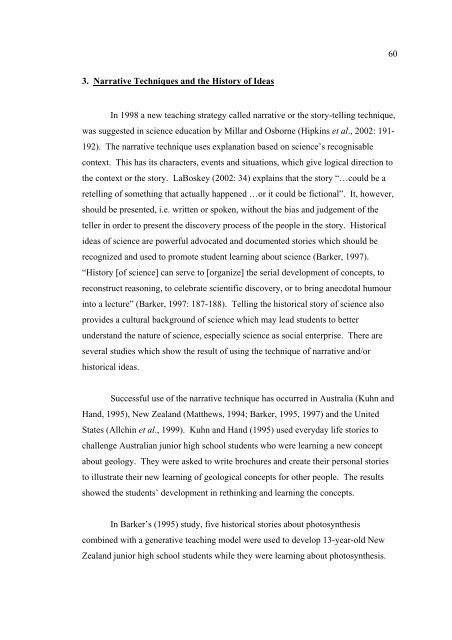an innovative approach
an innovative approach
an innovative approach
Create successful ePaper yourself
Turn your PDF publications into a flip-book with our unique Google optimized e-Paper software.
3. Narrative Techniques <strong>an</strong>d the History of Ideas<br />
In 1998 a new teaching strategy called narrative or the story-telling technique,<br />
was suggested in science education by Millar <strong>an</strong>d Osborne (Hipkins et al., 2002: 191-<br />
192). The narrative technique uses expl<strong>an</strong>ation based on science’s recognisable<br />
context. This has its characters, events <strong>an</strong>d situations, which give logical direction to<br />
the context or the story. LaBoskey (2002: 34) explains that the story “…could be a<br />
retelling of something that actually happened …or it could be fictional”. It, however,<br />
should be presented, i.e. written or spoken, without the bias <strong>an</strong>d judgement of the<br />
teller in order to present the discovery process of the people in the story. Historical<br />
ideas of science are powerful advocated <strong>an</strong>d documented stories which should be<br />
recognized <strong>an</strong>d used to promote student learning about science (Barker, 1997).<br />
“History [of science] c<strong>an</strong> serve to [org<strong>an</strong>ize] the serial development of concepts, to<br />
reconstruct reasoning, to celebrate scientific discovery, or to bring <strong>an</strong>ecdotal humour<br />
into a lecture” (Barker, 1997: 187-188). Telling the historical story of science also<br />
provides a cultural background of science which may lead students to better<br />
underst<strong>an</strong>d the nature of science, especially science as social enterprise. There are<br />
several studies which show the result of using the technique of narrative <strong>an</strong>d/or<br />
historical ideas.<br />
Successful use of the narrative technique has occurred in Australia (Kuhn <strong>an</strong>d<br />
H<strong>an</strong>d, 1995), New Zeal<strong>an</strong>d (Matthews, 1994; Barker, 1995, 1997) <strong>an</strong>d the United<br />
States (Allchin et al., 1999). Kuhn <strong>an</strong>d H<strong>an</strong>d (1995) used everyday life stories to<br />
challenge Australi<strong>an</strong> junior high school students who were learning a new concept<br />
about geology. They were asked to write brochures <strong>an</strong>d create their personal stories<br />
to illustrate their new learning of geological concepts for other people. The results<br />
showed the students’ development in rethinking <strong>an</strong>d learning the concepts.<br />
In Barker’s (1995) study, five historical stories about photosynthesis<br />
combined with a generative teaching model were used to develop 13-year-old New<br />
Zeal<strong>an</strong>d junior high school students while they were learning about photosynthesis.<br />
60
















